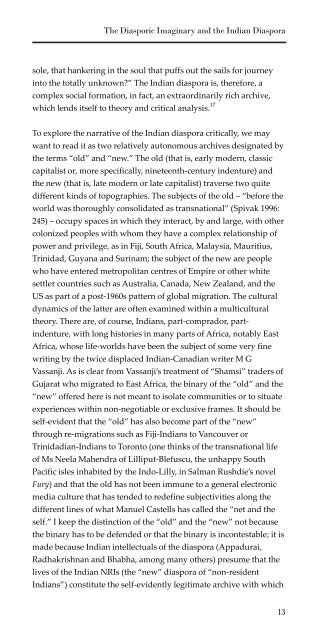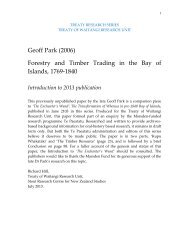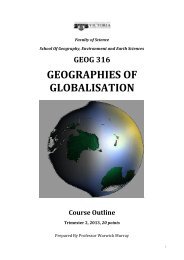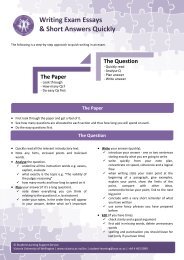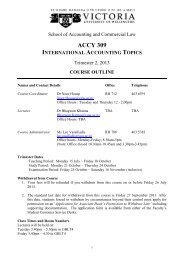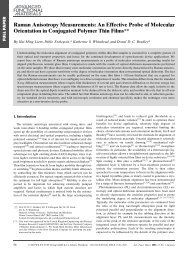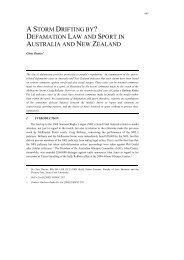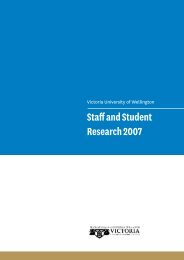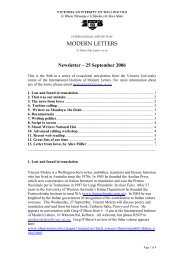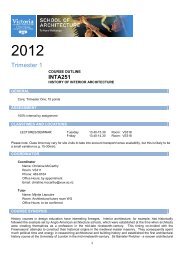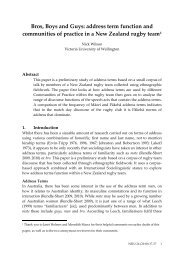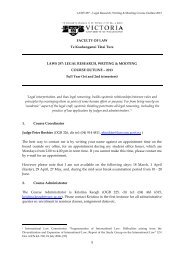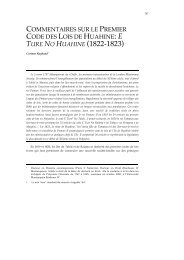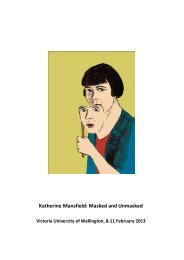The Diasporic Imaginary and the Indian Diaspora - Victoria ...
The Diasporic Imaginary and the Indian Diaspora - Victoria ...
The Diasporic Imaginary and the Indian Diaspora - Victoria ...
You also want an ePaper? Increase the reach of your titles
YUMPU automatically turns print PDFs into web optimized ePapers that Google loves.
<strong>The</strong> <strong>Diasporic</strong> <strong>Imaginary</strong> <strong>and</strong> <strong>the</strong> <strong>Indian</strong> <strong>Diaspora</strong><br />
sole, that hankering in <strong>the</strong> soul that puffs out <strong>the</strong> sails for journey<br />
into <strong>the</strong> totally unknown?” <strong>The</strong> <strong>Indian</strong> diaspora is, <strong>the</strong>refore, a<br />
complex social formation, in fact, an extraordinarily rich archive,<br />
which lends itself to <strong>the</strong>ory <strong>and</strong> critical analysis. 17<br />
To explore <strong>the</strong> narrative of <strong>the</strong> <strong>Indian</strong> diaspora critically, we may<br />
want to read it as two relatively autonomous archives designated by<br />
<strong>the</strong> terms “old” <strong>and</strong> “new.” <strong>The</strong> old (that is, early modern, classic<br />
capitalist or, more specifically, nineteenth-century indenture) <strong>and</strong><br />
<strong>the</strong> new (that is, late modern or late capitalist) traverse two quite<br />
different kinds of topographies. <strong>The</strong> subjects of <strong>the</strong> old – “before <strong>the</strong><br />
world was thoroughly consolidated as transnational” (Spivak 1996:<br />
245) – occupy spaces in which <strong>the</strong>y interact, by <strong>and</strong> large, with o<strong>the</strong>r<br />
colonized peoples with whom <strong>the</strong>y have a complex relationship of<br />
power <strong>and</strong> privilege, as in Fiji, South Africa, Malaysia, Mauritius,<br />
Trinidad, Guyana <strong>and</strong> Surinam; <strong>the</strong> subject of <strong>the</strong> new are people<br />
who have entered metropolitan centres of Empire or o<strong>the</strong>r white<br />
settler countries such as Australia, Canada, New Zeal<strong>and</strong>, <strong>and</strong> <strong>the</strong><br />
US as part of a post-1960s pattern of global migration. <strong>The</strong> cultural<br />
dynamics of <strong>the</strong> latter are often examined within a multicultural<br />
<strong>the</strong>ory. <strong>The</strong>re are, of course, <strong>Indian</strong>s, part-comprador, partindenture,<br />
with long histories in many parts of Africa, notably East<br />
Africa, whose life-worlds have been <strong>the</strong> subject of some very fine<br />
writing by <strong>the</strong> twice displaced <strong>Indian</strong>-Canadian writer M G<br />
Vassanji. As is clear from Vassanji’s treatment of “Shamsi” traders of<br />
Gujarat who migrated to East Africa, <strong>the</strong> binary of <strong>the</strong> “old” <strong>and</strong> <strong>the</strong><br />
“new” offered here is not meant to isolate communities or to situate<br />
experiences within non-negotiable or exclusive frames. It should be<br />
self-evident that <strong>the</strong> “old” has also become part of <strong>the</strong> “new”<br />
through re-migrations such as Fiji-<strong>Indian</strong>s to Vancouver or<br />
Trinidadian-<strong>Indian</strong>s to Toronto (one thinks of <strong>the</strong> transnational life<br />
of Ms Neela Mahendra of Lilliput-Blefuscu, <strong>the</strong> unhappy South<br />
Pacific isles inhabited by <strong>the</strong> Indo-Lilly, in Salman Rushdie’s novel<br />
Fury) <strong>and</strong> that <strong>the</strong> old has not been immune to a general electronic<br />
media culture that has tended to redefine subjectivities along <strong>the</strong><br />
different lines of what Manuel Castells has called <strong>the</strong> “net <strong>and</strong> <strong>the</strong><br />
self.” I keep <strong>the</strong> distinction of <strong>the</strong> “old” <strong>and</strong> <strong>the</strong> “new” not because<br />
<strong>the</strong> binary has to be defended or that <strong>the</strong> binary is incontestable; it is<br />
made because <strong>Indian</strong> intellectuals of <strong>the</strong> diaspora (Appadurai,<br />
Radhakrishnan <strong>and</strong> Bhabha, among many o<strong>the</strong>rs) presume that <strong>the</strong><br />
lives of <strong>the</strong> <strong>Indian</strong> NRIs (<strong>the</strong> “new” diaspora of “non-resident<br />
<strong>Indian</strong>s”) constitute <strong>the</strong> self-evidently legitimate archive with which<br />
13


